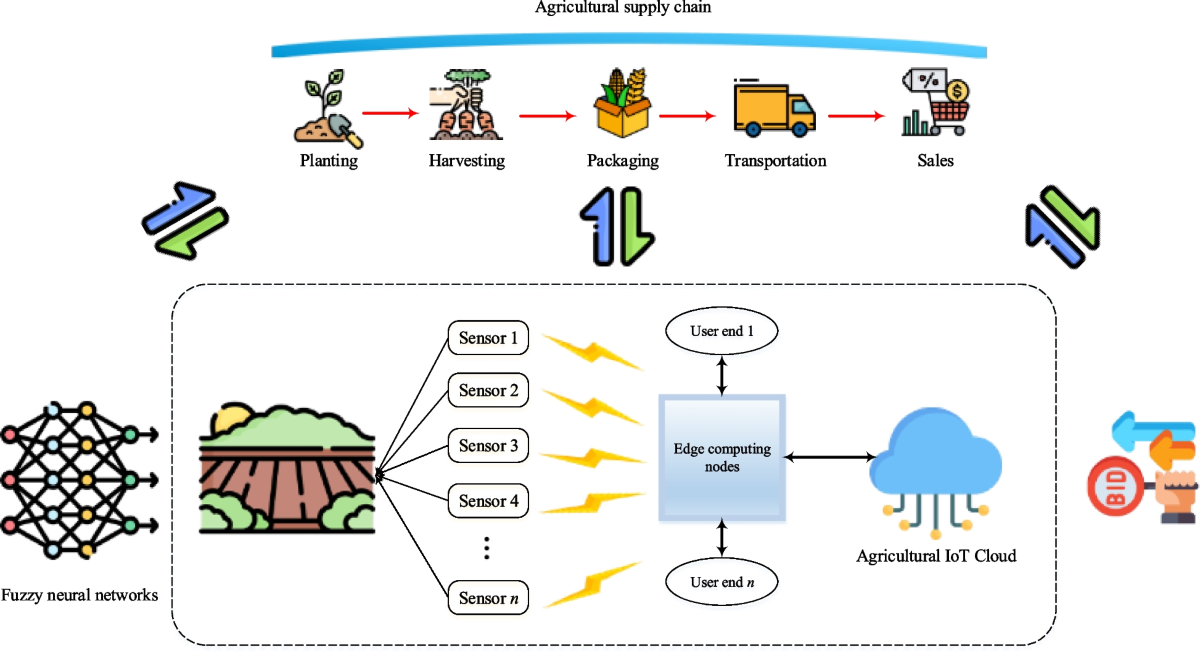Imagine a farm where the plants themselves tell you when they need water, where the soil predicts its own nutrient needs, and where the weather doesn’t just surprise you but informs your every decision. This isn’t a scene from a futuristic movie—it’s smart agriculture powered by edge computing.
Have you ever wondered how technology is transforming farming into an efficient, sustainable powerhouse? You’re about to discover how edge computing is the silent partner behind this agricultural revolution. It’s not just about faster data; it’s about smarter decisions, right at the source.
Dive into this world where technology meets nature, and see how it can transform your understanding of what farming can be. Are you ready to explore the future of agriculture? Keep reading to see how edge computing is making waves in the fields, and how it might just change the way you think about food production forever.

Edge Computing Benefits
Edge computing enhances smart agriculture by processing data closer to source. This reduces latency and improves real-time decision-making. Farmers can optimize resources efficiently, ensuring better crop yield and reduced waste.
In the rapidly evolving world of smart agriculture, edge computing is proving to be a game-changer. By processing data closer to where it is generated, edge computing offers distinct benefits that traditional cloud computing cannot match. These advantages can significantly enhance farming operations, making them more efficient, responsive, and sustainable.Reduced Latency
Imagine needing to make split-second decisions based on real-time data. With edge computing, data processing occurs right at the source, drastically cutting down the time it takes to get actionable insights. This speed is crucial for tasks like automated irrigation or pest control, where delays can impact crop yield.Enhanced Data Security
Data breaches in agriculture can have serious consequences. By keeping data closer to the source, edge computing minimizes the risk of exposure during transmission. This local processing ensures that sensitive information, such as proprietary crop data, remains secure.Scalability And Flexibility
Edge computing allows you to easily scale your operations. Need more processing power during harvest season? Simply add more edge devices without overhauling your entire system. This flexibility means you can adapt to changing conditions without significant investment.Improved Reliability
What happens if your internet connection drops? With edge computing, your operations don’t come to a standstill. Local processing ensures that critical functions continue uninterrupted, providing a safety net in connectivity-restricted environments.Energy Efficiency
Energy costs can add up quickly. Edge computing reduces the need to send large data volumes to remote servers, cutting energy consumption. This efficiency not only lowers costs but also supports sustainable farming practices. Have you ever considered how these benefits could transform your agricultural operations? Embracing edge computing might just be the strategic move your farm needs to thrive in the digital age.
Data Processing At The Source
Edge computing transforms smart agriculture by processing data at the source, enabling real-time decision-making. Sensors gather vital information directly from the fields, reducing latency and enhancing precision in farming practices. This technology optimizes resources and boosts productivity.
The landscape of agriculture is rapidly evolving, with technology playing a crucial role in transforming traditional farming practices. One of the most exciting advancements is edge computing, which promises to revolutionize how data is processed directly at its source. By harnessing the power of edge computing, smart agriculture can optimize data analysis, reduce latency, and enable real-time decision-making. Imagine being able to assess soil moisture levels, predict weather changes, and monitor crop health instantly, all without relying on distant cloud servers.What Is Edge Computing?
Edge computing refers to the practice of processing data close to where it is generated. Instead of sending information to a central cloud, data is analyzed and acted upon locally. This approach dramatically reduces the time it takes to get results, which is critical in agriculture, where timely decisions can impact crop yield.Benefits Of Processing Data At The Source
Processing data at the source offers numerous benefits. Speed is a major advantage. You can make immediate adjustments to irrigation or pest control based on real-time data. It also enhances accuracy, as data isn’t subjected to potential transmission errors. Additionally, it ensures privacy, safeguarding sensitive information by keeping it local.Practical Applications In Smart Agriculture
Picture this: you’re managing a farm with hundreds of sensors monitoring various conditions. Edge computing allows these sensors to process data right there in the field. This means you can immediately respond to changes, like adjusting water levels during unexpected droughts. It also enables drones equipped with edge computing capabilities to scan fields and instantly identify areas needing attention.Challenges And Considerations
While edge computing offers remarkable benefits, it comes with challenges. Infrastructure is one; farms need robust networks to support these technologies. Another consideration is maintenance; devices at the edge require regular updates and monitoring to function effectively. How prepared are you to adopt these technologies on your farm?Future Of Agriculture With Edge Computing
The future of agriculture is bright with edge computing. As technology advances, the precision and efficiency of farming will increase, leading to better yields and sustainability. This is not just about improving your farm; it’s about contributing to a global shift towards smarter agriculture. Are you ready to be part of this transformation? By embracing edge computing, you’re not just enhancing your farm operations; you’re paving the way for a smarter, more responsive agricultural industry.Enhancing Precision Farming
Edge computing transforms smart agriculture by processing data directly at the source. This technology boosts precision farming with real-time analytics. Farmers gain insights quickly, improving efficiency and crop management.
Enhancing precision farming with edge computing is transforming how we approach agriculture. Imagine a farm where decisions are made in real time, based on accurate data gathered from every corner of the field. Edge computing brings this vision to life by processing data closer to where it’s generated, allowing farmers to make faster, more informed decisions.How Edge Computing Reduces Latency
With edge computing, data doesn’t have to travel to a distant server for analysis. Instead, it’s processed on-site, significantly reducing the time it takes to get results. This means you can react quickly to changing conditions, like an unexpected pest outbreak or a shift in weather patterns.Boosting Efficiency With Real-time Data
Edge computing provides immediate access to critical information, helping you optimize resource use. Picture deploying sensors that monitor soil moisture levels, enabling you to water only when necessary. This precision not only conserves water but also boosts crop yields by ensuring plants get exactly what they need.Improving Crop Monitoring And Management
Edge computing allows for continuous monitoring of crop health using advanced sensors and cameras. You can detect issues like nutrient deficiencies or disease before they become widespread problems. Early intervention can save time and money, and lead to healthier crops.Enabling Smart Equipment
Imagine tractors and harvesters equipped with edge computing capabilities, adjusting their operations based on real-time data. These machines can work more efficiently, reducing fuel consumption and wear and tear. This technological advancement makes machinery smarter, enhancing productivity on the farm.Facilitating Autonomous Farming
Edge computing is paving the way for autonomous farming equipment. These machines can operate independently, performing tasks such as planting and harvesting with minimal human intervention. The result is a more streamlined operation, allowing you to focus on strategic decisions instead of routine tasks. By embracing edge computing, you’re not just adopting new technology; you’re fundamentally changing how you farm. Think about how these advancements could impact your daily operations. What challenges could you tackle with real-time data at your fingertips? How might your farm evolve with smarter equipment and autonomous capabilities? These questions are not just theoretical—they’re practical considerations for the future of farming. As you explore the possibilities of edge computing in agriculture, consider how it can enhance precision farming and transform your approach to growing food.Challenges And Future Prospects
Edge computing is transforming smart agriculture. It processes data close to the source. This enhances speed and reduces latency. Yet, challenges remain. Future prospects are promising. Let’s explore the challenges and the future of edge computing in agriculture.
Challenges In Edge Computing For Smart Agriculture
Edge devices face power limitations. Fields often lack stable power sources. This affects device performance and reliability. Another challenge is data security. Edge devices can be vulnerable to cyber threats. Farmers need robust security measures. Also, edge computing requires skilled personnel. Training farmers in technology is necessary.
Overcoming Connectivity Issues
Remote farms often lack internet connectivity. This hinders data transmission. Satellite internet services can help. They provide coverage in remote areas. Local networks are another solution. They enable communication between devices without the internet. Both methods can improve connectivity.
Future Prospects Of Edge Computing In Agriculture
Edge computing can make farms more efficient. It enables real-time data analysis. Farmers can make quick decisions. This leads to better crop management. Edge devices will become more affordable. This will increase their adoption. New technologies will enhance edge computing capabilities. The future looks bright for agriculture.
Integrating Ai With Edge Computing
Artificial Intelligence can enhance edge computing. AI algorithms can analyze data on-site. This reduces the need for cloud processing. It allows for faster insights. AI can predict weather patterns. Farmers can plan activities accordingly. The combination of AI and edge computing is powerful.

Conclusion
Edge computing transforms smart agriculture. It boosts efficiency and reduces costs. Farmers access real-time data for quick decisions. This technology enhances crop management. It helps monitor soil and weather conditions. Edge computing supports sustainable farming practices. It reduces waste and optimizes resources.
Farmers improve yield and quality. They use fewer chemicals and conserve water. Smart agriculture becomes more reliable and productive. Edge computing is vital for future farming success. Its role in agriculture grows stronger every day. Embrace technology for a better farming future.

